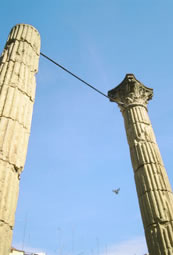
May
The Aplec of Saint Jeroni in Móra d'Ebre (1st May)One of the most rooted traditions in the demarcation is the one related on the celebration of aplecs or meetings, which are coincident with pilgrimages to hermitages that are placed in mountains and hills. Most of the encounters celebrate a religious profession, while typical jotas or sardanas are danced outside, and a meal which is especially cooked for the event. Pilgrimages, meetings and aplecs need the good weather and that is why the majority of them are celebrated during the months of spring and summer.
The aplec, specifically, is a traditional pilgrimage which makes the way towards the hermitages of Saint Jeroni and Saint Madrona. The day begins with the transfer in procession of the image of Saint Jeroni from its hermitage until that of Saint Madrona. Once the Eucharistic has been celebrated, the image is returned to its original space and the celebration is continued with games, dance of sardanasor jotas and the distribution of the traditional ranch for all participants.
The Dance of the Saint Christ in Salomó (all the Sundays of May)
It is a traditional party of national interest and it shows a performance that combines theater and dance which belongs to the traditional genre of spoken dances in El Camp de Tarragona. This dance shows on stage a legend of medieval roots. Regarding the hunger that suffered the village and the entire region, a merchant from Salomó, who was called Josep Nin, decided to embark towards Algiers in order to look for wheat.
Making deals with a Muslim merchant called Mahomet, Josep discovered the image of a Crucifix and he decided to acquire it anyway. After the initial negative of Mahomet, Josep Nin offered him so much silver as the image weighed but the merchant undid the deal; his basket only accepted thirty coins and he refused to give the image. Josep Nin resorted to the royal justice. The king commanded to repeat the operation in front of him and the result was exactly the same one than before: Christ only weighed the money that Judas had charged for its delation. Josep Nin embarked the Image and brought it to Salomó. The Saint Christ became the pattern of the town and stimulated an extraordinary devotion, even in the neighboring regions.
Initially, the Dance of the Saint Christ was represented in the requirement, as a show of street. At present, since 1972, it is held within the church under the advice of the Institute of the Theater of Barcelona, all Sundays of May.
Tarraco Viva (from 18 th until the 29 th May)
In order to revive the ancient Roman capital of the Iberian Peninsula, which August Emperor turn into the imperial see during the 2 years he lived there, Tarragona is transformed again into the ancient capital of the province Hispania Citerior through the organization of the Tarraco Viva’s celebration which is held every month of May.
A big range of activities are carried out during these days: cultural, scientific, informative, educational, ludic, gastronomic, musical and theatrical acts organized in the museums, in the street, on the table of the restaurants and on the archeologic vetiges. For these dates the Roman Legions retrieve all their forces with their arms and hierarchical organization, the roman school and the games of this period show how the children lived and the roman myths retrieve their value and space.
Approfondimenti
|
FORUM
